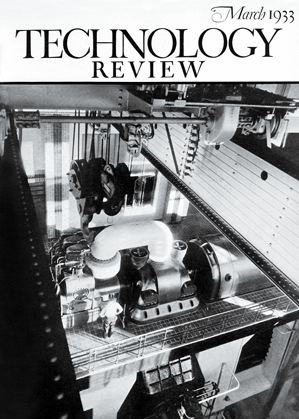The End of Drudgery
Excerpted from “Machinery and Unemployment,” by Dugald C. Jackson, head of MIT’s Department of Electrical Engineering from 1907 to 1935, in the March 1933 issue of Technology Review.

“Those who allege that the general introduction of machinery has been the cause of an unfair, disparate distribution of wealth and an overall instability of employment in this age must have failed to examine the facts, upon which the truth of such allegations must rest.
The old-time work period, beginning before sunrise and ending after sunset, has been lifted from the poor. The early factory period, an 84 or even 90-hour week, has come down to the 48, 44, or even 40-hour week. The dignity of the human mind makes it appropriate to relieve man-labor by substitution of machine-labor in drudge work, and invention is accomplishing the result.
In the United States, a highly mechanized nation, the proportion of the population ten years of age and older in gainful occupations has varied only six or seven per cent from its average figure during the 50 years from 1880 to 1930. Nevertheless, during the same time a large change occurred in the percentages employed in different occupations. The numbers of individuals gainfully occupied in trade, transportation, and clerical work expanded tremendously. Similar shifts have occurred in western Europe.
Employees of the more advanced ages and least mental skill are likely to be permanently displaced by such shifts. The uneducated and meager-minded man who is destitute is a continuing cost-burden to society; and it is a poor order of intellect which can look upon the poorhouse as a desirable haven for old age.
The only civilized cure is to prevent these changes from causing destitution. This may be done by placing responsibility on those commercial, industrial, or other profit-making activities favorably affected by the changes. Replacement of man-hours by machine-hours should be restrained unless the replacement enlarges net earnings sufficiently to provide a reasonable contribution for reestablishing the displaced employees’ status of living. Applying these principles would introduce a restraint upon the improper or socially unprofitable introduction of machinery.”
Keep Reading
Most Popular
Large language models can do jaw-dropping things. But nobody knows exactly why.
And that's a problem. Figuring it out is one of the biggest scientific puzzles of our time and a crucial step towards controlling more powerful future models.
The problem with plug-in hybrids? Their drivers.
Plug-in hybrids are often sold as a transition to EVs, but new data from Europe shows we’re still underestimating the emissions they produce.
Google DeepMind’s new generative model makes Super Mario–like games from scratch
Genie learns how to control games by watching hours and hours of video. It could help train next-gen robots too.
How scientists traced a mysterious covid case back to six toilets
When wastewater surveillance turns into a hunt for a single infected individual, the ethics get tricky.
Stay connected
Get the latest updates from
MIT Technology Review
Discover special offers, top stories, upcoming events, and more.